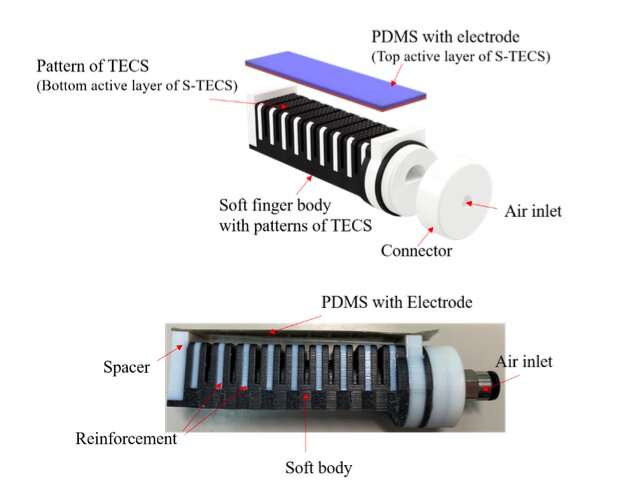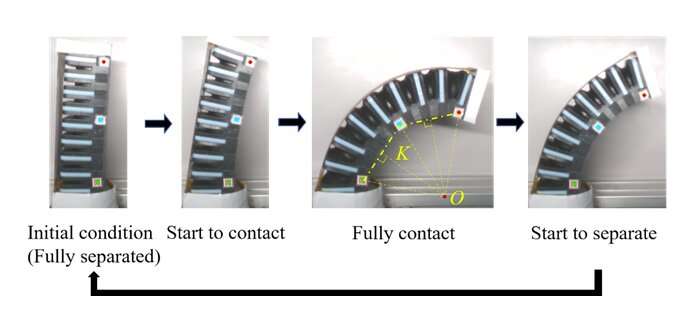May 14, 2020 feature
A soft robotic finger fabricated using multi-material 3D printing

Researchers at Zhejiang University of Technology, Tianjin University, Nanjing Institute of Technology and Ritsumeikan University have recently created a soft robotic finger that integrates a self-powered curvature sensor using multi-material 3-D printing technology. The new robotic finger, presented in a paper published in Elsevier's Nano Energy journal, is made of several materials, including a stretchable electrode, polydimethylsiloxane (PDMS), AgilusBlack, VeroWhite and FLX9060.
"Soft robots have the potential to bridge the gap between machines and humans, but it is important for them to ensure a safe interaction between humans, objects and the environment," Mengying Xie, co-author of the paper, told TechXplore. "Embedded soft sensors are critical for the development of controllable soft robots that can fulfill their full potential in practical applications."
In their previous research, part of the research team working at Ritsumeikan University developed a fully multi-material 3-D printed gripper with variable stiffness that could achieve robust grasping of objects. In this new study, Xie, Zhu and their colleagues drew inspiration from this previous work and set out to create a 3-D-printed soft finger with sensing capabilities that could monitor its bending movements.
The finger they developed has an embedded single-electrode triboelectric curvature sensor (S-TECS). It can sense the finger's bending curvature at ultralow working frequencies without requiring an external power source.
"Generally, a complex sensor fabrication process would lead to a long prototyping time and limits the potential of mass production," Xie said. "An unstable cable connection and complicated system assembly can result in the poor performance of the whole robotic system. In addition, difficulties in system integration of a flexible, light and small unit may arise due to the incompatible moduli between the soft body and attached sensors."
Xie and her colleagues manufactured their soft finger using state-of-the-art, multi-material 3-D printing technology. This technology allowed them to build the finger in a single step, significantly reducing the time necessary to create their first prototype.

S-TECS sensors like the one embedded in their robotic finger can effectively convert mechanical signals into electric signals. In past studies, these sensors have proved to be particularly promising for the development of efficient human-machine interfaces, motion monitoring devices and several other technological tools.
The sensor used by the researchers is powered via a process known as triboelectric charging. This process produces a contact electrification when a given material becomes electrically charged, for instance, after it is separated from a different material. This ultimately induces an electric potential difference that drives the free flow of electrons within the external circuit.
"In the embedded sensor we developed, the upper layer of the S-TECS was made from a PDMS with stretchable electrode and the bottom active layer with structured patterns was directly printed on the surface of the finger body," Xie explained. "The finger-bending motion leads to a contact between two functional layers of the S-TECS, activating the contact electrification and then generating electricity."
In their study, Xie, Zhu and their colleagues evaluated the performance of the S-TECS sensor under different conditions by changing the surface configuration, forces applied to it and operational frequencies in an automated setup. Overall, they found that the sensor could measure a finger curvature of up to 8.2m-1 with an ultra-low working frequency of 0.06 Hz. In addition, they found that integrating the sensor with different soft materials did not reduce the flexibility and adaptability of the overall robotic system.
The study demonstrates the feasibility of creating soft robotic structures with S-TECS functional triboelectric layers using multi-material 3-D printing technology. In the future, the method they employed could be used to produce a variety of other robotic systems with advanced sensing capabilities.
"Our study proves that multi-material 3-D printing can be used to fabricate not only the soft actuator, but also its functional sensor, paving the way toward a simple and fast manufacturing process for controllable soft robotics," Xie said. "Our future work will be aimed at developing closed-loop control of the soft finger curvature by using the developed S-TECS."
More information: Mingzhu Zhu et al. A soft robotic finger with self-powered triboelectric curvature sensor based on multi-material 3D printing, Nano Energy (2020). DOI: 10.1016/j.nanoen.2020.104772
© 2020 Science X Network



















